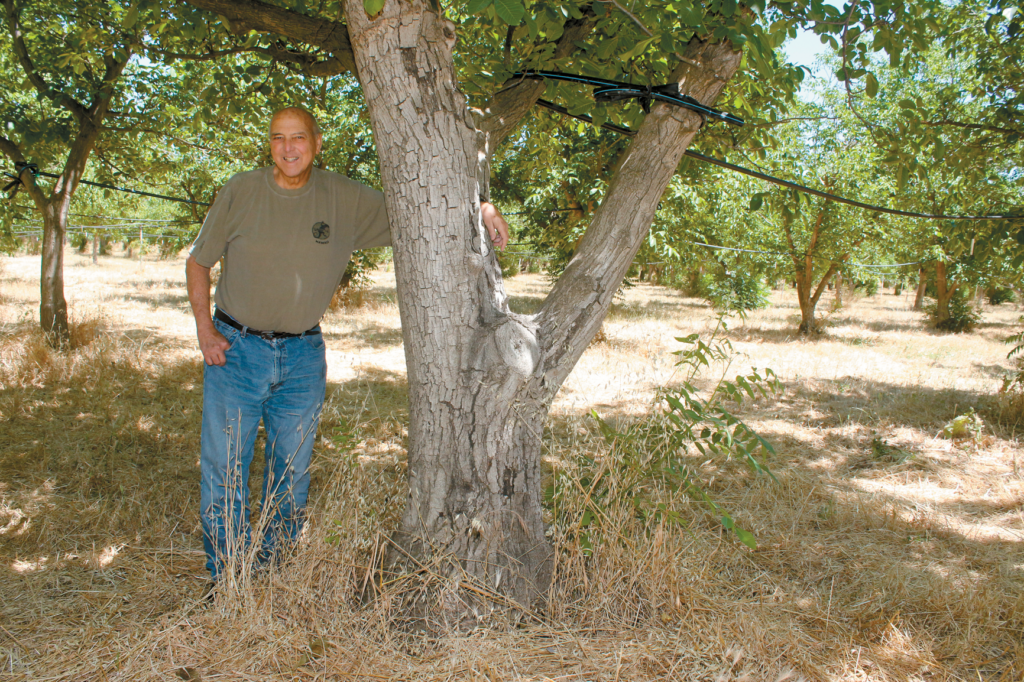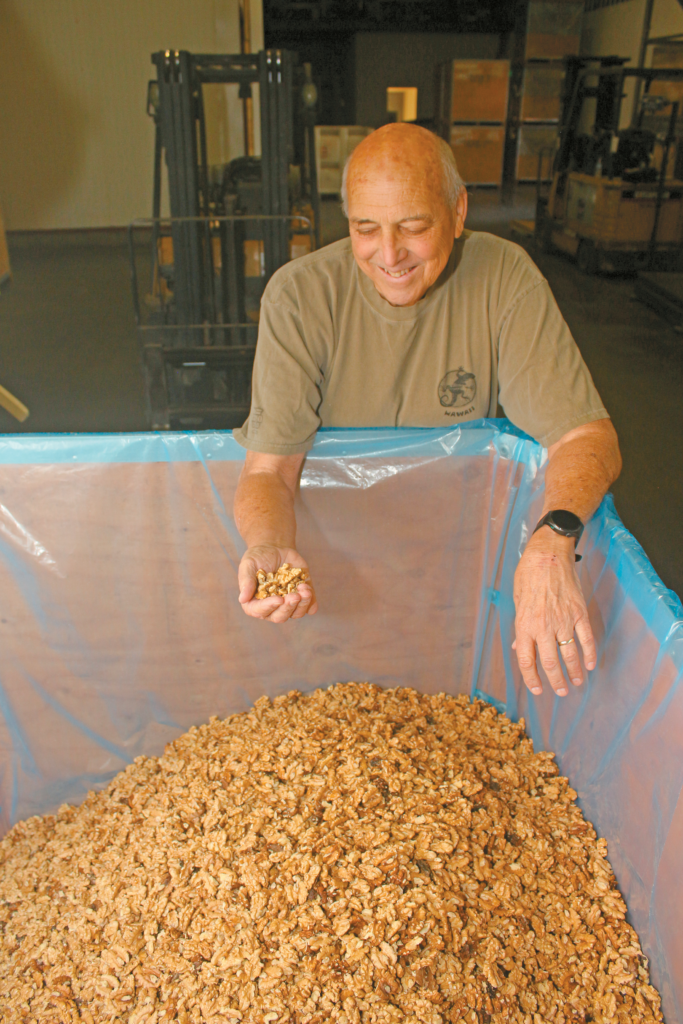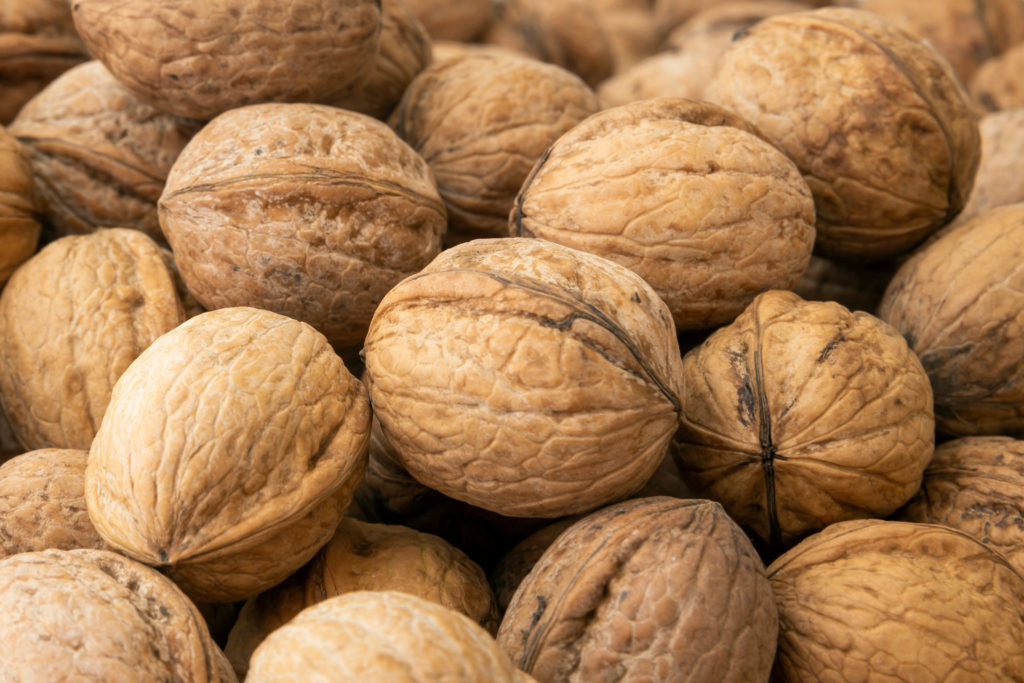
Aug 16, 2024Increased demand helps organic walnuts
Certified organic crops typically earn a higher price than their conventional counterparts, but for struggling California walnut growers, the organic premiums have not necessarily translated to higher profits.
The price of conventional walnuts has plunged to record-low levels in recent years, dragging down organic walnut prices. At the same time, “a steady increase in supply” has also weighed on the organic walnut market, said Teddy Schrier, who markets organic walnuts for Grower Direct Nut Co. in Stanislaus County.
“Once the supply got big enough to where it didn’t seem that the (market) was taking all of it easily, then prices don’t flourish,” he said.
California’s organic walnut sector remains small, with about 2% of total state production in 2023, or 18,514 tons compared to 805,035 tons of conventional walnuts, according to the California Walnut Board.
This is the first year the board has published numbers specific to organic walnut inventory and shipments, which the industry pushed for, Schrier noted. The new information should give growers and marketers a better idea of how big the organic crop is—and how much is being sold.

“It’s just helpful to see the demand that is there and to know that there is easily consumption for this supply of organic that we have in the California market,” Schrier said.
Though he described the organic walnut market as being in “a little better spot” than conventional, Schrier said grower prices remain lower than they’ve been historically due to “a bit of oversupply.” Demand has picked up, he said, and for the first time since the pandemic, the supply of walnuts—for organic and conventional—seems to be coming into balance with demand thanks to record shipments this year.
This is despite initial industry angst about a whopping 2023 crop of more than 823,000 tons and its potential impact on already below break-even prices for growers. With orchards being removed, a better-quality 2023 crop and willing buyers no longer sitting on excess inventory, “there’s a little bit of light at the end of the tunnel,” Schrier said.
Compared to conventional walnuts, of which 74% is exported, most organic walnuts stay in the U.S., with 20% going to foreign markets, according to shipment numbers from September 2023 to May 2024. Part of it may be that the rest of the world does not place the same value on organic as the U.S., which remains a key market for California organic walnuts, Schrier said.
That may be changing. With prices dropping by nearly 50% from four to five years ago, California organic walnuts have become more attractive the past couple years, he said. Countries that have purchased conventional walnuts from California are now also looking to the Golden State for organic walnuts, Schrier added. Whereas European buyers used to get their organic walnuts from countries closer to home, including from suppliers in eastern Europe such as Ukraine and Moldova, they are increasingly turning to California, he said.
Russ Lester’s Dixon Ridge Farms in Solano County has been certified organic since 1992. He also operates a processing facility and was once one of the state’s largest organic walnut handlers. Even though most of his walnuts are destined for foreign markets, he said he remains concerned about the industry’s dependence on export markets, which are affected by changes in global currency rates. A strong dollar typically makes American products more expensive and harder to sell.
Lester said much of the export business has also centered around the holiday season when walnuts end up in food products such as cookies and other baked goods.
“The ingredients market has never been very lucrative for walnuts anyway, especially if you’re trying to get rid of them all before Christmas,” he said.
Lester has scaled back his walnut acreage and processing business, noting “it’s been a bad five years.” Like other California shippers of agricultural products, he lost export business due to pandemic-related supply chain snarls and port delays. His buyers found other suppliers—largely from countries that compete with California—and never returned, he said.
In his domestic business, sales to local stores, restaurants, schools and other institutions also took a hit from the pandemic. Before that, retail customers such as Whole Foods Market and Trader Joe’s found less expensive organic walnuts from other countries as the price of the California product increased.
Bruce Bishop, a partner of Oso Nut Co. in Yuba County, said his company has dabbled in organic walnuts on and off but hasn’t processed or sold any for several years. His business is selling full container loads of walnuts across the world. To attract buyers, he needs a steady supply, and organic farms tend to be smaller, requiring more of them to get the supply he needs.
“There’s not enough volume in organic,” he said. “We just never got a big enough grower base to really have the relationship with buyers that we need.”
Now that some of her trees are aging out, Lake County grower Denise Rushing, whose farm has been certified organic for nearly 20 years, said she’s considering pulling them out and letting some of the land go fallow.
Most of her trees produce the Poe variety, a round English walnut grown only in Lake County. Though the nuts have a loyal following, they are not as marketable as “the big, beautiful Hartleys or Chandlers” that wholesalers favor, she said.
With the price collapse on the wholesale market, Rushing said she plans to do more direct marketing and focus on specialty markets, targeting customers who want Poe walnuts “and see if we can’t get a premium price.”
“I won’t say that we are a profitable walnut enterprise by any means at this point,” Rushing said. “It’s obviously cost us more to maintain this land than the walnuts are worth.” With the premium on organic shrinking, Rushing said she’s debated whether organic certification is worth the cost, particularly as recordkeeping has become “more onerous.”
Josh Barton, whose family business GoldRiver Orchards grows and processes walnuts in San Joaquin County, said the company has discussed whether to get into organic for about a decade but has yet to do so. With the depressed walnut market, the higher price for organic walnuts—though it’s come down—remains enticing, he said. Less so are the lower yields associated with organic farming, which eschews synthetic fertilizers and pesticides, and is “counterintuitive to the way we farm,” Barton said.
There’s also the hefty cost of maintaining certification, he said. The amount of reporting, auditing and recordkeeping for the farm and the processing facility may require hiring a third party, he noted, which “eats into your profitability.” What’s more, locating ground with a wide enough buffer zone from conventional crop production “is not something you can just whip out of thin air,” he added.
“All those things are on that scale to be weighed,” Barton said. “At the end of the day, everything has to make dollars and sense.”
—Ching Lee is an assistant editor of Ag Alert.
TOP PHOTO: Solano County farmer Russ Lester stands in his organic walnut orchard, which shows remnants of a leguminous cover crop that dies back in May and June. He says the cover crop fixes nitrogen to the soil, attracts beneficial insects and forms a heavy mat on the orchard floor, allowing him to use less water. Photo by Ching Lee.










